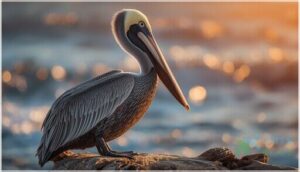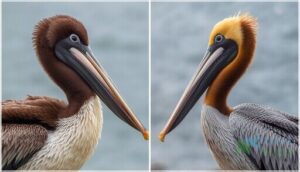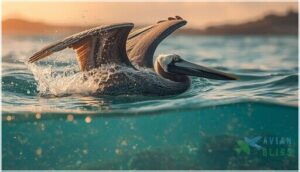This site is supported by our readers. We may earn a commission, at no cost to you, if you purchase through links.
You’ve probably watched a brown pelican torpedo into the ocean and wondered how something that awkward-looking on land transforms into such a precision instrument in the air. These coastal athletes aren’t just comically elegant—they’re engineering marvels wrapped in feathers, with expandable throat pouches that hold three gallons of water and specialized air sacs that cushion 40-mph belly flops.
Once pushed to extinction’s doorstep by DDT contamination, brown pelicans staged one of conservation’s most extraordinary comebacks, rebounding from critically endangered to thriving populations along both American coasts.
Understanding how these birds hunt, breed, and navigate their coastal kingdoms reveals not just their survival strategies, but why protecting their habitat matters for entire marine ecosystems.
Table Of Contents
- Key Takeaways
- Brown Pelican Identification
- Brown Pelican Habitat and Range
- Brown Pelican Behavior and Diet
- Brown Pelican Breeding and Life Cycle
- Brown Pelican Conservation Status
- Frequently Asked Questions (FAQs)
- How rare are brown pelicans?
- Where are brown pelicans found in the US?
- Why did the brown pelican go extinct?
- How do you identify a brown pelican?
- How fast can a brown pelican fly?
- Do brown pelicans migrate seasonally?
- Can brown pelicans swim underwater?
- How do brown pelicans communicate with each other?
- Are brown pelicans related to other seabird species?
- How long do brown pelicans live?
- Conclusion
Key Takeaways
- Brown pelicans aren’t just skilled hunters—they’re precision-engineered divers with specialized air sacs that cushion 40-mph plunges and throat pouches holding three gallons of water, making them one of nature’s most dramatic fishing machines.
- The species staged one of conservation’s greatest comebacks after DDT nearly wiped them out in the 1970s, rebounding from endangered status to over 370,000 birds through habitat protection, pollution control, and coordinated recovery efforts that prove targeted action works.
- These coastal athletes practice partial migration rather than rigid seasonal patterns, with some populations staying put year-round while others travel hundreds of miles following shifting prey schools as climate change reshapes their traditional ranges.
- Young pelicans master their signature plunge-diving technique through social learning by copying experienced adults, and those who mimic proficient hunters catch significantly more fish and survive better than birds trying to figure it out solo.
Brown Pelican Identification
You can spot a Brown Pelican from a surprising distance—their size, shape, and flight style give them away long before you catch the details. Once you’re closer, the plumage and that unmistakable pouch become dead giveaways.
Here’s what to look for when identifying these coastal characters in the wild.
Size and Plumage
You’ll spot a brown pelican by its hefty frame—adults stretch about 140 to 170 centimeters from beak to tail, with a wingspan reaching 210 to 245 centimeters. That impressive gular pouch beneath the beak structure can hold three gallons of water.
For a closer look at how brown pelicans compare with other birds of North America, consider their coastal feeding habits versus inland species.
Check out these plumage patterns:
- Adults sport a pale yellowish head with gray-brown body feathers
- Wing shape shows dark coverts contrasting lighter necks
- Juveniles display brown mottling that shifts through feather molting cycles
- Color variation appears subtly across coastal populations
- Size averages 2.3 to 3.2 kilograms in mature birds.
The study of bird species can involve scientific study methods to understand their behavior and habitat.
Distinctive Features
Beyond sheer bulk, your brown pelican (Pelecanus occidentalis) flaunts a comically elegant bill structure—that oversized gular pouch isn’t just for show. Watch how the head shape tapers to accommodate diving mechanics: plumage colors shift from gray-brown body to yellowish crown, while wing shape facilitates that signature low glide.
Unlike their American White Pelican cousins who feed cooperatively at the surface, brown pelicans perfected solo plunge-diving from heights up to 60 feet.
Beak functions extend beyond grabbing fish—during a plungedive, feather patterns compress to simplify the impact. The brown pelican’s conservation relies on understanding its marine life habits.
Adult Vs. Juvenile Appearance
You’ll notice plumage changes unfold gradually as brown pelicans mature. Juveniles sport uniformly dark brown heads and pale bellies, while adults develop that striking yellowish crown with a contrasting dark neck during breeding.
Beak development follows suit—young birds show horn-yellow bill tips that gray with age. Full adult appearance takes 3-5 years through successive feather molting cycles, making age identification straightforward once you know what to watch for.
For detailed guidance on distinguishing juvenile plumage from adult markings across species, check out this comprehensive bird identification guide for experts.
Brown Pelican Habitat and Range
You won’t find Brown Pelicans hanging around mountain lakes or prairie ponds—these birds are die-hard coastal residents. They’ve carved out a specific niche along warm shorelines from California to Peru and Florida to Brazil, sticking close to the saltwater environments where fish congregate.
Let’s look at where these plunge-diving experts make their homes and how they move through their range.
Their distribution spans coastlines and islands across the tropics and subtropics, though threats to eagle populations apply differently depending on regional human activity and habitat loss.
Preferred Coastal Environments
When you’re tracking brown pelicans, you’ll find them staging their comically elegant dives in specific coastal waters where the living’s easy. These seabirds don’t just pick any shoreline—they’re choosy about their marine habitats:
- Sheltered bays with calm, shallow waters perfect for spotting fish
- Fringing lagoons and reef zones where prey concentrates naturally
- Seagrass beds bordering productive foraging areas with convenient perches
Coastal ecosystems offering both food security and safe resting spots keep these birds thriving.
Geographic Distribution
From the Atlantic shores of New Jersey down through the Caribbean to South America, brown pelicans command a vast coastal range. Along US coasts, you’ll encounter breeding island colonies scattered from California’s Channel Islands to Louisiana’s barrier marshes.
Their chicks thrive on a diet rich in regurgitated fish, though understanding proper feeding schedules and nutritious food options for baby birds becomes critical if you’re rehabilitating orphaned pelicans.
Recent range maps reveal regional shifts northward—pelicans now appear regularly in British Columbia and even nest in the Columbia River estuary, pushing traditional ocean boundaries as climate reshapes their world.
Migration Patterns
Unlike most seabirds locked into predictable seasonal movements, brown pelicans practice what biologists call partial migration—some birds stay put year-round while others travel hundreds of miles along coastal migration routes. California breeders may wander north to British Columbia after nesting, then circle back by spring.
Climate influence reshapes these bird migration patterns as warming waters shift prey schools, and postbreeding dispersal can stretch from Channel Islands colonies clear to the Salton Sea, demonstrating striking geographic variation that challenges how we classify avian migration under frameworks like the Migratory Bird Treaty Act.
Brown Pelican Behavior and Diet
If you’ve ever watched a brown pelican hunt, you know it’s one of nature’s most dramatic feeding displays. These birds don’t just skim the surface—they’re full-commitment fishers with techniques honed over millions of years.
Here’s how brown pelicans find their meals and interact with their world.
Plunge-Diving Feeding Technique
You’ve likely seen a Brown Pelican’s stunning plunge-diving maneuver—it’s raw physics meets avian behavior. Climbing up to 20 meters, the bird tucks into a counterclockwise barrel roll before hitting water at 18 meters per second.
Dive kinematics reveal steep 60–90 degree angles that minimize refraction errors, while subcutaneous air sacs cushion impact forces.
These dive maneuvers and plunge dynamics showcase exceptional foraging efficiency in marine biology.
Primary Food Sources
When you watch Brown Pelicans plungediving, they’re almost always chasing schooling fish—especially menhaden, which can make up 90 percent of their diet in Gulf waters.
Diet composition shifts with prey availability: California birds target anchovies and sardines, while Atlantic populations hit mullet and herring.
These feeding habits show striking regional specialization, with each pelican downing roughly four pounds of fish daily.
Social and Foraging Behaviors
Young Brown Pelicans master plungediving by copying experienced adults—juveniles that mimic proficient hunters catch markedly more fish and survive better than those winging it solo. This social learning shapes Group Dynamics across foraging flocks, though success attracts trouble:
- Laughing gulls swarm pelicans mid-surface, stealing fresh catches in coordinated Kleptoparasitism raids
- Adults outfish immatures consistently, drawing heavier gull attention to their hauls
- Flocks shift foraging patches dynamically, tracking menhaden schools through temperature cues and plankton blooms
These Adaptive Behavior patterns make Brown Pelicans among the most strategically social marine birds you’ll encounter.
Brown Pelican Breeding and Life Cycle
Brown pelicans don’t follow a one-size-fits-all playbook regarding raising their young—their breeding strategies shift with the seasons and the safety of their chosen sites. From courtship displays to the moment chicks take their first clumsy flight, each stage reveals how these birds balance survival instincts with coastal realities.
Here’s what you need to know about their nesting habits, chick development, and the seasonal sites they call home during breeding season.
Mating and Nesting Habits
When breeding season kicks off—anywhere from midwinter in the Gulf to year-round in the tropics—you’ll witness colony dynamics in full swing as male pelicans defend prime nesting spots for weeks.
Their courtship rituals feature head swaying and low, raspy calls to attract mates. Once pair bonding succeeds, both birds gather nesting materials like sticks and seaweed, creating platforms that cradle two to four chalky eggs.
Chick Development and Care
After those chalky eggs hatch in about 30 days, you’ll find naked, helpless chicks weighing just two to three ounces—completely dependent on parental care for warmth and food. Both parents share brooding behavior and feeding duties, regurgitating fish that nestlings eagerly devour.
White down sprouts around day ten, and as the weeks roll on through breeding season, rapid growth transforms these vulnerable hatchlings into feathered juveniles ready for fledging stages around nine to eleven weeks.
Seasonal Breeding Sites
You’ll find brown pelican breeding seasons shift dramatically with latitude—spring through summer egg-laying dominates colonies above 30 degrees north, while tropical Caribbean sites host nearly year-round nesting patterns.
Colony stability depends on predator-free island habitats along coastal beaches and lagoons, where barrier islands and mangroves provide essential nesting substrates.
Bird migration patterns and coastal ecology shape when these colonies form and dissolve seasonally.
Brown Pelican Conservation Status
The brown pelican’s comeback from the brink of extinction stands as one of conservation’s most dramatic success stories. After DDT nearly wiped them out in the 1970s, targeted recovery efforts brought them back from endangered status to thriving populations along both coasts.
But their story isn’t over—new challenges keep conservationists on their toes, and understanding what threatens these birds today helps protect tomorrow’s coastal skies.
Population Recovery Efforts
By the 1970s, brown pelicans had vanished from much of their range, victims of DDT poisoning that left eggshells too fragile to hatch. Then conservation planning kicked in. Species recovery hinged on five pillars:
- Banning DDT in 1972 stopped reproductive failure.
- Habitat restoration secured nesting islands.
- Species monitoring tracked population rebounds.
- Threat assessment identified ongoing risks.
- Recovery strategies enabled delisting by 2009.
Wildlife conservation efforts proved pelicans could bounce back.
Current Threats and Challenges
Recovery doesn’t mean safety. Climate change swallows Louisiana nesting islands at a football field per hour, while oil spills like Deepwater Horizon killed 27,000 Gulf pelicans in 2010.
Recovery doesn’t guarantee safety—climate change devours Louisiana nesting islands while oil spills have killed tens of thousands of Gulf pelicans
Plastic pollution tangles and poisons birds hunting contaminated waters. Harmful algal blooms trigger seizures.
Human disturbance at roosts, habitat destruction from development, and fishing gear entanglement keep pressure high on this endangered species comeback story.
Ongoing Conservation Measures
You’ll find Brown Pelican conservation thriving through coordinated protection measures that address modern threats head-on.
- Habitat Protection: Marine refuges safeguard critical nesting islands and foraging zones, while coastal regulations limit development that threatens roosting sites
- Pollution Control: Fishing line recycling stations and angler outreach reduce entanglement injuries
- Wildlife Rehabilitation: Centers treat thousands of injured pelicans annually, with banding programs tracking survival to prove recovery efforts work
Climate resilience planning now guides bird conservation strategies coastwide.
Frequently Asked Questions (FAQs)
How rare are brown pelicans?
You won’t struggle to spot these coastal divers today—the global Brown Pelican population has bounced back to over 370,000 birds.
Impressive Conservation Efforts have reversed their Endangered Species decline, earning them a Least Concern IUCN Status.
Where are brown pelicans found in the US?
You’ll spot them along all three US coasts—Atlantic shores from Maryland to Florida, Gulf Coast states, and Pacific waters from Washington to California, with island breeding colonies thriving offshore.
Why did the brown pelican go extinct?
The species didn’t go extinct—though DDT pesticide poisoning nearly caused that outcome during the 1960s. Habitat loss and contaminated prey pushed populations toward extinction risks before conservation efforts reversed the endangered species’ decline.
How do you identify a brown pelican?
Look for a large, comically elegant bird with a massive hooked beak and expandable throat pouch. Check feather patterns—grayish-brown body, pale head, dark underwings. Wingspan stretches over seven feet, unmistakable along coastlines.
How fast can a brown pelican fly?
Brown pelicans cruise at 22 to 30 miles per hour with surprisingly few wing beats, using aerodynamic gliding to slash wind resistance.
You’ll see these airborne maneuvers along shorelines during any bird watching trip.
Do brown pelicans migrate seasonally?
Like clockwork, these coastal wanderers follow the fish. Brown pelicans migrate seasonally—northern populations drift southward in winter, chasing reliable feeding grounds along flexible flyway routes rather than rigid north–south highways.
Can brown pelicans swim underwater?
While you might expect impressive diving mechanics, these birds don’t actually swim underwater. Their buoyancy control keeps them bobbing at the surface—they snatch fish during the initial plunge, then immediately pop back up.
How do brown pelicans communicate with each other?
Think of a silent film with a soundtrack—that’s how these avian species use multimodal communication. You’ll observe visual displays like head-swaying and bowing paired with acoustic cues including guttural “hrraa-hrraa” calls during social interactions and courtship.
Are brown pelicans related to other seabird species?
Yes—molecular studies reveal pelicans share ancestry with shoebills, hamerkops, herons, and ibises within Pelecaniformes. Their closest kin are Peruvian pelicans, while gannets and cormorants represent more distant seabird evolution branches.
How long do brown pelicans live?
These coastal giants can reach 43 years in the wild, though most survive 15 to 30 years. High juvenile mortality rates and fishing gear entanglement shape brown pelican survival trends and longevity records.
Conclusion
The brown pelican’s comeback proves that even species on life support can bounce back when we actually commit to fixing our mistakes. These coastal acrobats survived DDT’s chemical assault through decades of patient conservation work, reminding you that protecting habitat isn’t just feel-good environmentalism—it’s essential infrastructure for marine ecosystems.
Next time you watch one nail a plunge-dive, remember you’re witnessing resilience in motion, feathers and all.











